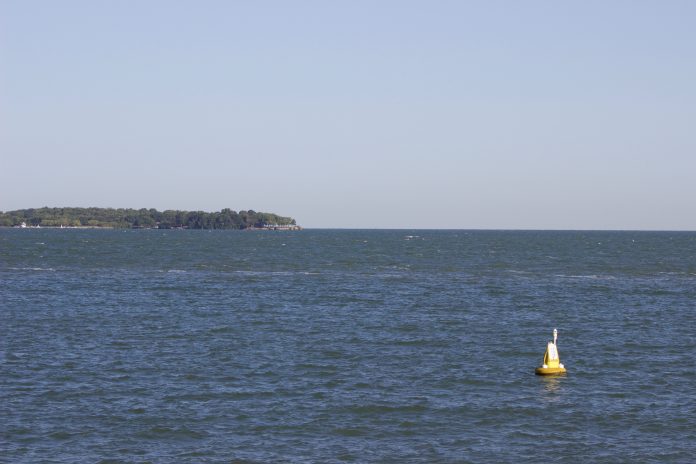Western Lake Erie got its first-ever report card Aug. 14. It needs to bring its grades up, scientists and politicians say.
The University of Maryland Center for Environmental Sciences scored both the Western Lake Erie basin and the Western Lake Erie watershed in a report card for the year 2018.
The basin scored 58%, a C+, based on indicators in water quality, fish and algal blooms.
The watershed scored 49%, a C, based on indicators in water quality, toxics and biology.
The report card is designed to communicate scientific data on the lake’s health to the public and create accountability for taking care of the lake.
The report card found that nutrient pollution is a major issue for the watershed and leads to lower quality habitats for the fish and animals there. It said much of the phosphorus load, which contributes to harmful algal blooms, comes from commercial fertilizers and manure used on agricultural fields and residential lawns.
Bill Dennison, vice president for science applications at the center, said other report cards the center has done have influenced policies and regulations on water quality. The center has been doing report cards for the Chesapeake Bay for 14 years, and has helped start initial report cards for other locations around the world.
Impact
Dennison said report cards the center did for Chesapeake Bay contributed to improving water quality in the area by drawing attention to the issue. Up until 2010, he said, voluntary efforts were not adequate.
The problem in the Chesapeake Bay was dissolved oxygen, he said. In 2010, the U.S. Environmental Protection Agency put a total maximum daily load, sometimes called a “pollution diet,” which establishes the total amount of pollution the bay can receive and still meet state water quality standards, in place.
“These report cards can be catalysts to the kind of change and the kind of actions that need to take place,” Dennison said.
The Ohio Environmental Protection Agency announced in February that it will develop a total maximum daily load for the western basin of Lake Erie over the next two or three years.
Laura Johnson, director of the National Center for Water Quality Research at Heidelberg University, said trying to make the data she and other scientists collect easy for the general public to understand can be challenging. She sees the report card as a way to fill the gap.
Tom Bridgeman, director of the University of Toledo Lake Erie Center, said the report card could also be a safe guard to keep people from becoming complacent.
“It’s not as bad this year as in some past years,” he said about water quality challenges in the lake. “But it’s still unacceptable.”
Government
The report was funded by the cities of Toledo and Oregon, Ohio, and Lucas County, through the Lake Erie Foundation.
During the virtual press conference, Toledo Mayor Wade Kapszukiewicz said 11 million people rely on Lake Erie for drinking water. He believes that the science is clear and there are ways to address the issue, but that there is a lack of political will to fix it.
“There’s been a lot of carrots thrown at the problem and not enough sticks,” he said.
Data
In the watershed, water quality scored 35%, toxics scored 61% and biology scored 51%.
For the basin, the water quality category scored the lowest, at 28%. Algal blooms and fish had good scores, at 78% and 66%, respectively.
Dennison said the northwest part of the basin was healthier than the southwest region and suggested that water coming from Lake Huron improved the water quality in that area.
The center used data from groups including the Ohio Environmental Protection Agency, the National Oceanic Atmopsheric Administration, universities including Ohio State University, the Ohio Department of Natural Resources and many others.
Dennison acknowledged that there are many factors that can affect indicators from year to year, such as the climate and the amount of rain, and the report card needs to take those yearly variations into account.
Future reports
In the future, scientists at the University of Toledo will conduct the report card with support from the center. Bridgeman helped put together the group that will take over the report card. The important thing is not the scores today, he said, but how they improve over time.
“The report card sets a benchmark,” Bridgeman said.
Alexandra Fries, of the University of Maryland, said there has been discussion about releasing the next report card in 2022, and that it could cover data from either 2019 or 2020, but the timing will depend on funding.
The full report card and more information can be found at lakeeriereportcard.org.











